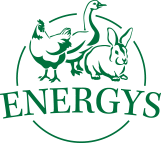Rabbits
Poultry
Laying hens
Quails
Guinea pigs
Pigs
Ostriches
Sheep and goats
Pigeons
Pheasants
Forest animals
Raising ducks
We can divide people who raise ducks into two types. One type purchases three-day old ducklings every year and raises them until they are ready for slaughter. The second type is professionally engaged in raising ducks, not only for producing meat, but also for their ornamental qualities, which some breeds are distinguished by, and devotes time to breeding them according to the standard.
It is true that only someone who has enough land to provide the ducks with the required space and access to water can raise ducks. One must also be considerate of the neighbours, because duck breeds derived from the wild duck (mallard) are distinguished not only by their greater need for water, but also their voices. Muscovy ducks are quiet, which is why they are more suited for some conditions.
Duck house
The duck house should have a floor area that allows the breeder to keep it clean, replace the bedding, clean out the nests and feeders easily. A height of around 250 cm, doors that are 80 x 20 cm, floor area depending on the number of adult ducks plus ducklings. Adult ducks are hardy and do not suffer from the cold. It is important to consider prevention against bird flu. The aviary adjoining the duck house should be enclosed by small square wire netting, with eyes small enough to prevent sparrows and mice from passing through. There should also be netting on the ceiling of the aviary and the entire aviary should be roofed with either corrugated metal or perspex.
How many ducks?
Sufficient space in the duck house is a key condition for keeping your duck in good health and maintaining high production. You can keep a maximum of four Indian runners or Campbell ducks, and three ducks of other breeds, including Muscovy and ornamental breeds, per 1 m2 of floor space in the enclosed duck house. (Malík, V., 1991). Muscovy ducks (also called Barbary ducks in other countries) are very fertile, the female duck sits on the hatching eggs and rears the ducklings until they are independent. Anyone who keeps ducks will be satisfied with just one pair, because if they are provided with the proper care and sufficient pasture, they can rear up to 40 ducklings from two nests.
Raising requirements
Ducks are not sensitive to cold and cope well with changing weather conditions. A 35 x 50 x 45 cm (width x height x depth) nest box must be prepared for each breeding duck – layer in the duck house . This ensures that the hatching eggs have a clean shell, and the contents are not infected. The temperature in the duck house should be around 5 to 6 oC during laying. The eggs are collected every day. The duck house should be dry. The bedding can be straw, shavings or sawdust.
Feeding
Ducklings aged up to 3 weeks are fed a moistened mixture of crushed grain, hard-boiled, finely-chopped eggs, finely chopped green feed. The first few days after they hatch, this mix is given to the ducklings on a feed board, which is removed after feeding, washed and left to dry. From the fifth day, the ducklings can be provided with shallow feeding bowls and drinking blows, and also grit bowls with fine grit.
Ducks are among the fastest growing poultry. At two months of age they resemble adults thanks to their great natural voraciousness. But only if we provide them with feed containing the optimum amount of nutrients. Finely chopped nettles, dandelions, alfalfa, young grass and other green feed, mixed with crushed corn and other grains, is also fed.
Under small-flock conditions, the most popular feed is grain – wheat, corn, oats – whole or crushed. It is a good idea to supplement the crushed grain with a protein concentrate, e.g. the general-purpose POULTRY UNI 30 for fattening all categories of poultry. This contains the highest quality soy. This is mixed with grain at a ratio of 20 – 40% (depending on breed or phase of fattening). It contributes towards rapid growth and increased meat production.
Complete feeds for water fowl are also manufactured. For instance the Energys 7370 HU gr. feed for promoting laying. From the first day after they hatch, ducklings can be fed with DUCK MINI, high-quality crushed mixture with a balanced ratio of nutrients, intended for fattening ducks and geese up to 2 weeks of age. After fourteen days you can start feeding DUCK MAXI pellets for fattening ducks and geese, until they are ready to be slaughtered. This contains a balanced ratio of nutrients and cereals to promote rapid growth, increased meat production and a delicate 0flavour to the meat.
Where to obtain a duck?
Ducks can be ordered or purchased direct from breeding farms. These are exclusively commercial hybrids such as the Mallard, broiler Peking and Barbary ducks.
Breeders interested in purebred duck breeds can contact breeders through adverts, at breeder exchanges and animal shows.
Secondary product – feathers
Just like geese, adult ducks can also be plucked. If the owner does not pluck the feathers, they fall into the bedding and are composted. A slaughtered duck produces 120 – 140 g of feathers when plucked. Plucking ten ducks at once results in quite a lot of feathers, these should not be thrown into the communal waste or the organic waste bins. The feathers should be dried and sold to a feather supplier.
What should you do with meat scraps
Meat scraps consist of intestines, scraps of skin, and some people also discard the head and feet. These should also not be placed in the communal waste or organic waste. This material can be utilised, the intestines slit along their entire length, flushed and boiled with the remaining scraps. This is not pleasant work, but the cooked product will be enthusiastically received by cats and dogs. These secondary products, feathers and offal, often become part of illegal rubbish heaps after a large number of fowl are slaughtered.
Production of droppings
Nowadays we endavour to raise animals without producing too much waste. Duck droppings with bedding can be transformed into compost. If the ducks have an outdoor run with vegetation, the droppings produced over the day remain in the run. One duck produces 80 – 90 kg of droppings a year. The soiled bedding taken to the dung heap during regular cleaning of the duck house floor and run, must be added to this amount. If fattening one drake and three ducks, this may amount to 500 kg or more a year. This amount of droppings and bedding forms fresh manure. Its production depends mainly on the amount of drinking and bathing water provided to the ducks. Duck droppings are more liquid than the droppings of land fowl. The manure is taken to the reserved area, if possible fenced in with pallets for example. Composting of manure can be accelerated by applying special bacteria and enzymes for liquidation of biological waste, and also by adding California earthworms The manure can be converted to compost within three months. This compost is suitable for immediate fertilization.
BREEDS OF DUCK AND COMMERCIAL HYBRIDS
MULARD DUCK
Final hybrid This is the typical goose type duck (it has nothing in common with geese). This hybrid was selected by geneticists in France. It is a hybrid of the Barbary duck and the Peking duck. It reaches a weight of up to 4.2 kg in 84 days. Drakes weight practically the same as ducks. This is a hybrid for producing a large roast, with excellent juicy meat, especially after being force fed with corn. They are quiet, do not quack and do not make too much noise in the yard. They can be pastured and do not require too much feed.
PEKING BROILER DUCK
Final hybrid. This is the highest-performing broiler duck from a super-heavy line from the French manufacturers of this breed CHERRY VALLEY, also called the English hybrid or Peking duck It reaches a weight of over 3 kg aged just 45 days. Ducklings reach weights of over 0.5 kg at 2 weeks of age. Each individual consumes around 10 kg of feed throughout the fattening period.
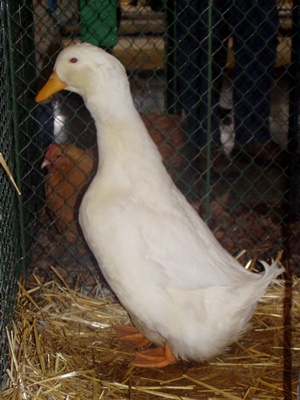
BARBARY – MUSCOVY DUCKS
The drake reaches a weight of around 5 kg, ducks weigh roughly half. The distinctive feature of drakes in particular is their naked red warty skin with a rounded fleshy protrusion above their dark beak. The duck has very slightly warty skin on her head.
People interested in breeding and further selecting purebred breeds of duck have a wide range of options in Slovakia. Breeders, members of the Slovak Association of Breeders, breed many world renowned breeds, used for utility and ornamental purposes. Some of them are available in many colours.
The Muscovy duck is bred in its original wild colour, and also in blue, brown, white, black and white, blue with brown barring, and also white-headed wild and in other colours and patterns.
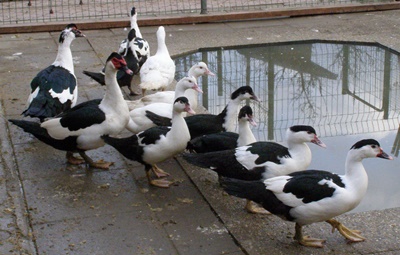
Duck breeds derived form the wild duck
The Rouen duck, Saxony duck, Cayuga, Campbell duck, Abacott Ranger duck, White Crested duck, Indian Runners and others. You can see these ducks for yourselves at one of the larger animal shows, or google them on the internet.
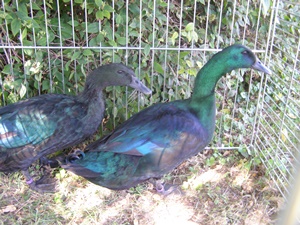
Related products
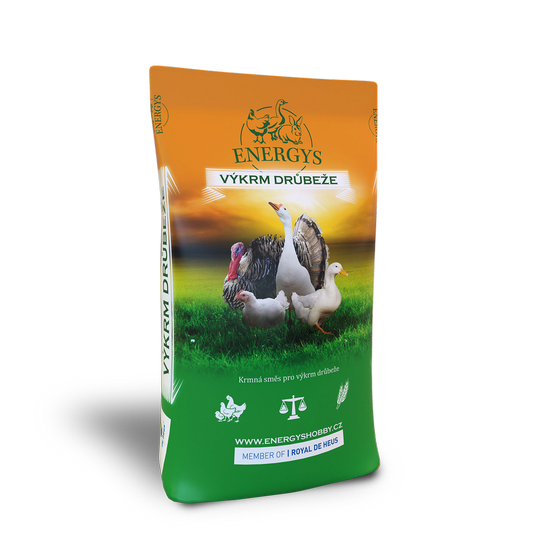
POULTRY UNI 30
A mashed concentrate for fattening of all categories of poultry, which includes the highest quality soja. It is mixed with cereals in a ratio of 20-40% (by type or phase of fattening). It contributes to fast growth and a high meat content. It does not contain coccidiostats.

BROILER MAXI
Feed for the final phase of fattening broilers. Supports a high meat content and a delicate meat taste. Start using it 5 or more days before slaughter. Does not contain coccidiostatics.

BROILER MIDI FORTE
A granulated feed mix for the intensive fattening of broilers from 15 days of age to a minimum of 5 days before ending feeding up. The Coccidiostat included lowers mortality during fattening. For the next phase of fattening Broiler MAXI is a suitable mix.

BROILER MINI FORTE
A ground feed mix with Coccidosistats, for the intensive feeding of broiler chickens up to 14 days of age and a support to fast growth a an excellent state of health in your broliers-

DUCK MINI
A high quality ground mix for fattening ducks and geese up to their 2nd week. It is suitable for fast growth and high meat content.

TURKEY MAXI
Feed for the final stage of turkey fattening. Use from the 13th week of age. It does not contain a coccidiostat.

TURKEY MIDI FORTE
A high quality granulated feed with coccidiostats for feeding turkeys from 5 to 12 weeks of age. It is the basis for fast growth, high meat content and an excellent state of health of your turkeys. The coccidiostat content lowers mortality during feeding. It continues on from feeding with Turkey Mini Forte. The live weight for turkeys at the end of this period should be around 5.9 kg for hen turkeys and 8.9 kg for cocks.

TURKEY MINI FORTE
A ground mix with Coccidiostats for fattening turkeys up to an age of 4 weeks. It is the basis for high meat content. Afterwards use the Turkey Midi Forte mix.

DUCK MAXI
A granulated mix for feeding ducks and geese from 3 weeks of age up to slaughter. The nutrients it contains support fast growth , a high meat content and a delicate meat taste.
